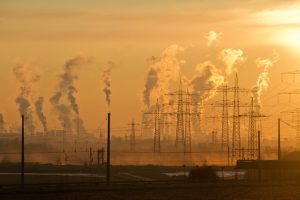Written by Lucas Cirigliano & Lucas Girardet
Reading time: 15 minutes
Between the 6th and the 20th of November 2022, the 2022 United Nations Climate Change Conference took place in Sharm El Sheikh, an important Egyptian city of tourism and trading. During the event, almost 35 000 people (representing states and governments, civilian society, but also non-governmental organizations, regional governments, or scientists) were reunited with the aim of finding solutions against climate change. Particularly, the developed states had to come to an agreement on the financing of loss and damage endured, for the most part, by developing states, which are also the poorest. As a reminder, scientists estimate “loss and damage” developing states’ cost of 1700 billion dollars in 2050, which is so much more than what should be allocated to climate change adaptation and prevention.
-
What is the problem?
Because of massive anthropogenic greenhouse gas emissions, the earth’s global warming is increasing dangerously. This global increase in the earth’s temperature has led to the melting of glaciers, the rise of the sea level, hurricanes, and drought.
-
To understand the future, look at the past:
Facing this dramatic situation, the United Nations Framework Convention on Climate Change was adopted by 178 states reunited during the Rio’s Earth Summit in 1992. According to their commitment, states decided to meet every year to reflect on solutions. The first Conference of the Parties took place in 1995 in Berlin and the first binding text was adopted in 1997 in Kyoto. Unfortunately, it was ratified only by developed states.
During the COP 15 of Copenhague, the developed states promised 100 billion per year to developing states to fight against climate change and finance adaptation.
-
While we are discussing, our home is burning:
The 2022 United Nations Climate Change Conference is taking place in serious geopolitical anxiety. While Egypt is hosting COP27, the water sharing of the Nile, a river vitally important for many farmers, is not guaranteed. Indeed, rising global warming, increasing evaporation, massive exploitation by farmers and inhabitants lead to serious exhaustion of the Nile. Above all, the multiplication of water impoundment by states in the upstream part of the Nile, like the Grand Ethiopian Renaissance Dam, leaves Egyptians without enough water to live.
In Latin America, the degradation of the Amazon rainforest is alarming. Amazon rainforest is being subject to catastrophic deforestation and biodiversity’s weakening. This assessment is directly due to policies in place which be advantageous to an economic development based on changing landforms from a natural state to intensive agriculture
In the Indian subcontinent, Pakistan endured very high heat. The flow from Indus has decreased by 65% in 2022 while it is providing Pakistani for 90% of their water consumption. Furthermore, Pakistani were touched by catastrophic floods. On 31 August 2022, satellites detected more than 86 000 square kilometers of flooded lands, almost 10% of the entire surface area of Pakistan. According to official estimations, one thousand three hundred people died because of this disaster.
As you can see, the situation is dramatic and will be more serious in the future. That is why the propositions and commitment made on this “African COP”, as Emmanuel Macron said, are so important. The Secretary-General of the United Nations, Antonio Guterres, summed up the situation of our civilization by declaring: “we have to cooperate, or die”.
In a globalized and interdependent society in which money is the news of war, it seems interesting to focus our article on the financial aspect of the problem. More specifically, we would like to put the light on the European Union’s place in the global financing of climate change combat.
In the first part, we would like to talk about which type of financing tools could be used at the global level in relation to the debate conducted during COP 27. The second part would be focused on the participation of the EU with the support of member states and the role it must play.

Debates and decisions at COP 27
Creation of a fund for loss and damage
The State Parties to COP 27 took decisions, but among them, the creation of a loss and damage fund is the most important.
The principle of compensation for the states most affected by global warming by historical polluting states has been enshrined in the UNFCCC since 2013, when the Warsaw mechanism was created. But this mechanism, enshrined in Article 8 of the Paris Agreement, was devoid of real effectiveness and was only intended to study what loss and damage are. The European Union has always refused the creation of such a fund.
The EU’s turnaround to create a fund this year is historic. But for the moment, we just know little about it.
The general idea would be the creation of a fund fed by “large contributors”. Note that this wording possibly includes China, a state that has always been ranked among the developing countries under the UNFCCC annexes (China has no binding obligation). However, the creation of the fund has been decided, and it should be effective in 2024 on the occasion of COP 28.
After stormy negotiations, particularly on the question of equity (who should contribute to this fund?), the developed countries finally adopted this proposal from the developing countries. The countries will now have to start the real work:
- Defining the functions of this fund;
- Figuring out where to find the money to provide it;
- Finding out how to ensure that the money goes to the people who need it most.
Unfortunately, COP27 lacked concrete results on finance for adaptation and mitigation in developing countries. Yet, adaptation was one of the stated priorities of the Egyptian presidency. Last year, developed countries committed to doubling adaptation funding by 2025. COP27 should have set a clear roadmap to achieve this goal. This was not the case.
In total, some thirty countries have committed to mobilize more than $350 million to address the impacts of climate change. However, this progress remains minimal compared to the needs, estimated at between 290 billion and 580 billion dollars per year until 2030 in developing countries.
However, there is more encouraging news. States were able to reach an agreement to make the Santiago Network on Loss and Damage operational from 2023. Created in Madrid in 2019, the role of this network is to provide technical assistance to vulnerable countries so that they can assess and cost their loss and damage needs, and identify the type of interventions needed to address them.
Two other ideas were also put forward by the EU. The first one concerns the reform of the development banks. A second one is on the possible suspension of debt payments of countries vulnerable to climate change. On this point, the text of the decision supports a reform of the financial system to help the most vulnerable countries. The idea, supported in particular by France, is to review the functioning of the World Bank and the International Monetary Fund, to push development banks to lend more money to vulnerable countries, and to suspend the repayment of their debts in the event of a climate disaster.
The challenges of future COPs will therefore be to increase the capacity to contribute to the fund, find new funders, and methods of defining beneficiary countries.
The project is still in its infancy, and the European proposals on financing issues will certainly be a subject of tension in the coming years.
A lack of progress on fossil fuels
Along with biodiversity, fossil fuels remain the “great absentees of the COP 27”. Indeed, in the context of the many geopolitical crises surrounding the issue of oil and gas, the question of accelerating the reduction of greenhouse gas emissions was only barely mentioned. The text only mentions the end of fossil fuel subsidies, which are considered useless. However, this same promise had already been made during COP 26 in Glasgow.
The combustion of fossil fuels is the main source of greenhouse gasses worldwide. There are structural obstacles preventing the States from getting out of it, but also legal obstacles. This is the case with the Treaty Energy Charter. Conceived with the objective of protecting the investments of companies and States in the field of energy, this charter with binding value appears to be a means for companies to prevent the energy transition. Indeed, by allowing companies and investor states to sue defendant states in arbitration courts, the treaty is a threat to low-carbon energy transition policies.

European efforts as an extension of the international commitment
Climate change is a global problem that requires global solutions. In this context, cooperation between states seems vital. The European Union could play a key role in financing climate change combat for many reasons. First, EU member states are historically responsible for greenhouse gas emissions and they have, with the EU itself, approved the CCNUCC of 1992. Secondly, the EU has great potential. Indeed, it manages by many institutions, and the European Union law is a system of rules operating within the member states. Last but not least, the EU is the second-world economic place (17% of world GDP), ahead of China (17%) and behind the United States (25%). At the end of the day, it could be influential in the negotiation and become an “imagining force of law” (M. Delmas-Marty, Les forces imaginantes du droit, Seuil, 2004) to contribute to developing new legal tools to finance adaptation and prevention against dramatic effects of climate change.
The improvement of the Emission Trading System (ETS)
Coming from Article 6 of the Kyoto Protocol to the UNFCCC, the EU ETS has long suffered from the major problem of free allowances for certain sectors. This situation led to “free rights to pollute”, going against a founding principle of European environmental law: the “polluter should pay” principle. Many associations have pointed out that this signal was not likely to encourage companies to reduce their emissions.
In June 2021, a new legislative package will be proposed by the Commission to include emissions from buildings and road transport in the ETS.
However, these measures have been criticized by environmental and climate change organizations. Indeed, the June 2021 package still excludes the shipping and aviation sectors, even though they account for nearly a third of European transport emissions and are still increasing compared to emissions from industrial sectors.
In response, on June 8, 2022, the European Parliament adopted new measures to include the maritime and aviation sectors in the emissions trading market, and also to strengthen the obligations of companies by ending the free allowance system. According to the new European directives, the end of free allowances will be gradual and should be definitive by 2030.
MEPs want to cover 100% of emissions from intra-European journeys from 2024 and 50% of emissions from extra-European journeys to and from the EU from 2024 until the end of 2026. From 2027, emissions from all trips should be covered at 100% with possible derogations for non-EU countries where coverage could be reduced to 50% under certain conditions
However, new ideas for improvement remain to be considered. In 2021, French economist and ministerial advisor Géraud Guibert proposed solutions. According to him, the trading system must send an unambiguous signal on the future evolution of the CO2 price in this market. The emissions cap must be strengthened and a corridor must be set in advance to mark out its future trajectory. A target of about 100 euros per ton of CO2 (i.e. a tripling of the current price) seems appropriate.
Debates on the dissuasive effect of prices on the emission quota market
The EU ETS is the largest cap-and-trade’s system in the world, created in the context of the Kyoto protocol’s ratification. Unfortunately, it is not satisfactory because the price of carbon dioxide ton is too low. Indeed, in 2017, the price varied between 5 and 10€ per carbon dioxide ton while it should almost be 60€ in 2030 to respect the Paris agreement’s goals. This assessment is obviously due to an excessive quota’s emission of carbon dioxide, which leads to a decrease in the ton’s value. Furthermore, the EU ETS only takes into account 45% of carbon dioxide emissions in the entire EU territory. Maybe the Carbon Pricing Leadership Coalition – which brings together leaders from the government, private sector, academia, and civil society to expand the use of carbon pricing policies – could play a key role in the improvement of the EU ETS.
The new « carbon border adjustment mechanism »
Adopted by the July 2021 legislative package, the carbon border adjustment mechanism aims to avoid carbon leakage and to continue the European efforts under the Green Deal. Indeed, there is a significant risk of “carbon leakage”, i.e. that EU-based companies could move their carbon-intensive production abroad to take advantage of lax standards, or that European products could be replaced by more carbon-intensive imports.
This system will work through the purchase of carbon certificates by European producers. These certificates will correspond to the carbon price that would have been paid by the producer under the ETS if the product had been produced in the EU. The system also works the other way around: a producer from a third country who has demonstrated that he has paid the carbon price for his product will have this cost deducted when the product enters European territory.
On this point, the Climate Action Network notes that the effectiveness of the mechanism will vary according to the evolution of the free distribution of emission allowances. The European Parliament has found a solution to this problem: the definitive extinction of free allowances, but this is not expected before at least 2032.
Economic advances at the same time
During the Group of Twenty (G20), the European Union committed to investing 10 billion euros to encourage the autonomy of Indonesia concerning its use of coal in its development and to reach carbon emissions’s neutrality in 2050. As a reminder, coal was used for 62% of the electricity production and represents almost 40% of its energy mix. Nevertheless, the country has great potential for renewable energies. Indeed, the geothermal energy of the country would be 10 times higher than what is used now.
For the same reasons, the EU (with the assistance of Germany, the United States, France, and the United Kingdom) had proposed, during COP 26, to finance for 8.5 billion euros South Africa’s autonomy.
By way of “return on investment”, UE could guarantee itself a nickel procurement (Indonesia owns one-quarter of the world stock of nickel) while it is an indispensable metal for Li-ion battery production. This assessment brings the developed states’ dependence regarding developing states to light.
Focus on European Investment Bank and European Central Bank’s assets
Concerning the ECB:
According to treaties, the ECB has two main purposes: guaranteeing and maintaining price stability and supporting economic policies of the eurozone.
In consequence, climate change has to affect these purposes to justify an ECB’s intervention.
Climate change already had repercussions on raw material prices and led to tensions in marketplaces (wheat for example). This is why ECB had integrated ecological transition as part of its purposes.
ECB has already do action to participate in climate change’s fight of the EU. For instance, it has established supervision and improvement of indicators, data, and stress tests. ECB has also created the Network for Greening the Financial System (NGFS) which is a network of 114 central banks and financial supervisors that aims to accelerate the scaling up of green finance and develop recommendations for central banks’ role in climate change.
In order to develop the efficiency of the ECB, many improvements could be done:
- Determine ECB’s financing to the implication of national banks in ecological transition;
- Establish an “ecological” quantitative easing which could help to purchase government bonds according to ecological transition;
- Increasing stress tests which estimate the resilience of companies and banks to several climate scenarios provided by the Network for Greening the Financial System.
That demonstrates the fundamental importance of statistical data to quantify the effects of global warming on prices and to carry out his duty to stabilize them.
In the end, there is an important challenge of designing indicators that will be used to assess the exposure of banks to climate risks.
Concerning the EIB:
In 2019, the EIB adopted 3 ambitious goals for climate action and environmental sustainability:
Firstly, the EIB Group (EIB and EIF) will support the mobilization of €1 trillion of investment in support of climate action and environmental sustainability over the decade 2021-2030.
Then, there will be a gradual increase in the share of EIB financing devoted to climate action and environmental sustainability in order to cover more than 50% of its operations from 2025.
To finish, the EIB Group will align all of its financing activities with the principles and objectives of the Paris Agreement before the end of 2020.
To appreciate the assets of EIB and to put light on the European Union’s place in the global financing of climate change combat, it seems appropriate to look into the EIB Group Climate Bank Roadmap 2021-2025:
It is the result of several rounds of consultations with civil society and other stakeholders.
The roadmap outlines the EIB’s high ambitions in climate finance to support the European Green Deal and make Europe a carbon-neutral continent. It describes the next steps in the development of sustainable investment and provides a framework for combating climate change and protecting the environment in the decade 2021-2030.
But the EIB also works with large corporations to align them with the objectives. Large companies are required to publish their alignment plans, including a mid-term carbon emissions target. These plans should also aim to build resilience to future climate change. The EIB will work with its clients to develop and publish such plans.
In summary, the main actions of the EIB relate to:
- Financing projects which could reduce or avoid greenhouse gas emissions;
- Investmenting in climate change adaptation projects;
- Implementing an environmental and social sustainability framework (composed of an environmental and social policy, and environmental and social standards);
- Contributing to the transposition of the ambitions of the “Green Deal for Europe” into reality (€250 billion in the Green Deal Investment Plan).
To conclude, the European Union has many tools at its disposal and could use its own institutions to play a crucial part in the global financing of climate change combat.
If the EU would successfully takes up the challenge, it could be another demonstration that there is strength in unity.
Maybe it will be possible to draw some conclusions next year with COP 28 of Dubai, where it will be the time to implement the disappointing COP 27’s agreements.
 From our partner: ALYDE – Association Lyonnaise de Droit Européen
From our partner: ALYDE – Association Lyonnaise de Droit Européen
The Association Lyonnaise de Droit Européen (ALYDE) was created in 2018 and brings together students from the Masters in European Business Law, European Human Rights Law and Global Climate Change Law at Jean Moulin Lyon III University.
REFERENCES
Website
https://www.pourleco.com/monde/comment-la-bce-entend-reconcilier-finance-et-climat-en-trois-points
https://ec.europa.eu/commission/presscorner/detail/en/qanda_21_3661
https://www.eea.europa.eu/fr/themes/transport/intro
Books
Emanuel Castellarin, « investissement », in « Répertoire de droit européen », Editions Dalloz, november 2021
Reinhard Mechler, Laurens M. Bouwer, Thomas Schinko, Swenja Surminski, Joanne Linnerooth – Bayer, « Loss and damages from climate change », Springer Open Edition, 2019
Cahier du « Monde » N°24209, Saturday 5th of november 2022
Courses
Business and Climate change – 2022 – Etienne DURAND – University Jean Moulin Lyon III
Energy Law – 2022 – Etienne DURAND – University Jean Moulin Lyon III
International and European Climate Change Law – 2022 – RICARD Pascale, PhD in public law – University Jean Moulin Lyon III


